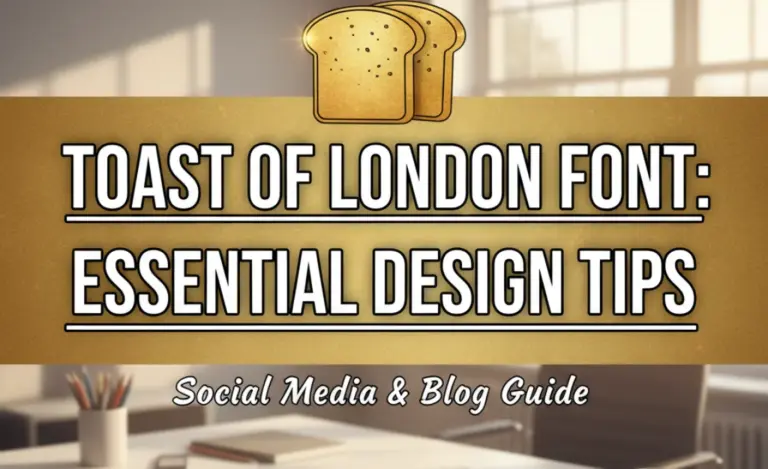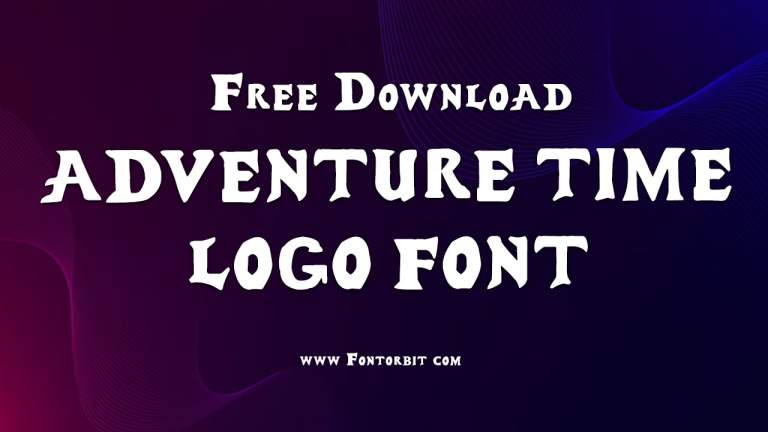Chalk fonts bring a charming, textured feel to designs, mimicking the look of hand-drawn chalk lettering. To use them for stunning designs, focus on readability, context, and supporting graphics. Choose chalk fonts that are clean enough to read easily and pair them with backgrounds or elements that enhance their rustic, handmade aesthetic.
Ever scrolled through Pinterest or Instagram and seen those gorgeous, hand-lettered designs that look like they were drawn with real chalk? That’s the magic of chalk fonts! They’re super popular for adding a personal, artistic touch to everything from wedding invitations to cafe menus and even website headers. But sometimes, trying to use them can feel a bit… messy. Letters can get blurry, or the whole design might end up looking a little too busy to understand. Don’t worry, though! With a few simple tips, you can harness the unique charm of chalk fonts and create designs that truly pop. We’ll walk through exactly how to make your chalk font designs look amazing, so get ready to add some delightful texture to your creative projects!
What Exactly is a Chalk Font?
At its heart, a chalk font is a typeface designed to imitate the look of letters written with chalk. This isn’t just about a simple white-on-black effect. True chalk fonts capture the subtle imperfections: the powdery texture, the slight variations in stroke thickness, the gentle smudges, and the grainy quality you get when chalk meets a surface like a blackboard or rough paper.
These fonts are fantastic for creating a:
- Rustic feel: Perfect for bakeries, artisanal shops, or anything with a handmade vibe.
- Hand-lettered aesthetic: Gives designs a personal, organic, and often informal touch.
- Nostalgic or vintage charm: Reminds us of school days, old movie theaters, or cozy coffee shops.
- Playful and creative atmosphere: Ideal for educational materials, event invitations, or creative workshops.
Think of them as digital brushstrokes that carry the character of traditional art materials. They’re versatile, but understanding their nature is key to using them effectively.
Why Are Chalk Fonts So Popular?
The appeal of chalk fonts is multifaceted. They offer a delightful escape from the crisp, perfectly rendered digital fonts we see everywhere. Here’s why they’ve captured designers’ hearts:
- Authenticity and Warmth: In a world of digital perfection, the slight imperfections of chalk fonts feel real and approachable. They convey a sense of human touch and authenticity that resonates with audiences.
- Visual Texture: The inherent texture of chalk adds a unique visual interest that can make designs stand out. It’s a subtle way to add depth and character without being overwhelming.
- Versatility in Application: While they evoke a specific style, chalk fonts can be adapted for a surprisingly wide range of projects. They can lean towards elegant and chic or be utterly playful and whimsical, depending on the font and how you use it.
- Nostalgia Factor: For many, chalk brings back fond memories of childhood, school, or simpler times. This nostalgic connection can create a powerful emotional response in the viewer.
- Contrast and Readability (when used well): Despite their texture, many chalk fonts are designed with clear letterforms that remain readable, especially when placed against appropriate backgrounds. This balance is key to their success.
Choosing the Right Chalk Font: Key Considerations
Not all chalk fonts are created equal! Just like picking any other font, you need to be strategic. Here’s what to look for:
1. Intended Use and Readability
This is paramount. Ask yourself: “Who is going to read this, and where will they see it?”
- For large headlines or short phrases: You can get away with more decorative or textured chalk fonts. Think wedding signage, menu titles, or a catchy slogan.
- For longer text or body copy: This is where it gets tricky. Most chalk fonts are NOT suitable for paragraphs. Their texture and often irregular shapes can make them hard to read in small sizes or when used for extensive blocks of text. If you absolutely must use a chalk-like font for longer content, opt for a cleaner, more legible version often found in font families or as a “chalkboard style” text effect rather than a true chalk font.
- Screen vs. Print: Some chalk fonts have fine details that might get lost or pixelated on screens, while others might appear too bold or smudged in print. Test your chosen font in its intended medium.
2. Texture and Detail Level
Chalk fonts vary greatly in how much they mimic real chalk:
- Fine Grain: These have a subtle, powdery texture.
- Heavy Texture: These fonts look like they’ve been applied with a thick piece of chalk, with more visible grit and variation.
- Smudged Effects: Some fonts include intentional smudges or uneven edges.
- Clean Strokes: Others are cleaner, offering a more stylized, graphic interpretation of chalk.
Consider the overall vibe you want. A heavily textured font is great for a rustic bakery sign, but might be illegible for a modern, minimalist product label.
3. Font Style and Personality
Chalk fonts come in a variety of styles, much like handwriting:
- Brush Scripts: Mimic the sweeping, bold strokes of a chalk brush.
- Handwritten Sans-Serifs: Casual, slightly irregular block letters.
- Handwritten Serifs: Similar to sans-serifs but with chalky imperfections on the serifs.
- Decorative or Whimsical: Often with unique ligatures, flourishes, or exaggerated styles.
Match the font’s personality to your brand or project. A playful, bouncy chalk font might be perfect for a children’s party invitation but less so for a sophisticated wine bar.
4. Supporting Glyphs and Ligatures
Some advanced chalk fonts come with:
- Alternate characters: Different versions of the same letter to create a more natural, hand-drawn look.
- Ligatures: Connected letter pairs that flow seamlessly.
- Swashes and Flourishes: Decorative extensions to add flair.
If you want a truly custom, hand-lettered feel, look for fonts that offer these extra features. They require a bit more typesetting effort but can yield stunning results.
5. Source and Licensing
Always ensure you are using fonts legally! Check the licensing terms for both free and paid fonts. Free fonts might have restrictions on commercial use. Paid fonts often come with various licenses (desktop, web, app) depending on how you plan to use them. Reputable font foundries and marketplaces are your best bet.
Tips for Using Chalk Fonts in Your Designs
Here’s where we get practical. Applying chalk fonts effectively involves more than just typing them out.
1. Choose the Right Background
The classic pairing is chalk font on a dark, textured background resembling a chalkboard. This is a foolproof way to enhance the chalk effect. Think deep blues, blacks, grays, or even dark wood textures. However, don’t feel limited! Chalk fonts can also look surprisingly good on:
- Kraft paper textures: For a rustic, crafty feel.
- Wood grain backgrounds: Adds warmth and natural element.
- Subtle, muted colors: For a softer, more contemporary take.
- Clean white or light backgrounds: For a minimalist, airy look, especially if the chalk font has a subtle outline or is used as negative space.
Avoid busy backgrounds that will compete with the texture of the font and hinder readability.
2. Master the Color Palette
While white is the traditional color for chalk, you can experiment:
- Classic White/Off-White: Always a safe and effective choice on dark backgrounds.
- Pastel Chalk: Think light pinks, blues, or yellows for a softer, often more feminine feel.
- Vibrant Chalk: Bold blues, reds, or greens can make a statement, but use sparingly to maintain legibility.
- Subtle Grays: For a more muted, sophisticated look.
Consider your overall design and brand colors. The chalk color should complement, not clash.
3. Leverage Textures and Effects
To really sell the chalk look:
- Add a subtle texture overlay: Apply a subtle paper or chalkboard texture over your text in your design software. This can further enhance the grainy, imperfect quality.
- Mimic smudges: Manually add subtle smudges or erase edges of letters using a soft brush in Photoshop or similar tools. Be careful not to overdo this; a little goes a long way.
- Create depth: Use subtle drop shadows or inner shadows to give the impression of the chalk sitting on the surface, rather than being flat.
Many design software programs offer built-in texture brushes or filters that can help achieve this.
4. Balance Readability and Style
This is the biggest challenge with chalk fonts. Always test your text at its intended size and distance.
- Use for short phrases: Headlines, titles, or key words are ideal.
- Combine with a simpler font: Pair a chalk font headline with a clean, sans-serif font for body text or supporting information. This creates visual hierarchy and ensures your message is clearly communicated.
- Adjust letter spacing (kerning): Sometimes, chalk fonts need a little manual adjustment between letters to make them flow better or space out more evenly.
- Consider letter casing: Uppercase can sometimes be more readable for chalk fonts, but lowercase can offer a more casual, handwritten feel. Test both.
5. Context is Key
Think about where your design will appear. A chalk font might be perfect for:
- Cafe or restaurant menus: Adds a cozy, artisanal vibe.
- Wedding invitations or signage: Creates a romantic, informal, or rustic feel.
- Boutique shop branding: Enhances a handmade or vintage appeal.
- Event posters: For workshops, farmers’ markets, or creative fairs.
- Personal blogs or websites: For sections where you want to add personality and warmth.
A good example of an authoritative resource for understanding typography principles, including the use of display fonts like chalk styles, can be found on the Libraries Connected website, which discusses typographic practices and considerations in design.
Tools and Resources for Finding & Using Chalk Fonts
Ready to dive in? Here are some places to find great chalk fonts and tools to help you use them:
Where to Find Chalk Fonts:
- Google Fonts: Offers a selection of free, high-quality fonts, some with a hand-drawn or textured feel that can approximate chalk.
- Adobe Fonts: If you have an Adobe Creative Cloud subscription, you get access to a vast library of professional fonts, including many hand-drawn and chalk-style options.
- Creative Market: A popular marketplace for independent designers selling fonts, graphics, and templates. You’ll find a huge variety of unique chalk fonts here.
- MyFonts: One of the largest font retailers online, offering a massive selection from various foundries.
- Font Squirrel: Curates free, commercial-use fonts, and also offers a great font identifier tool.
Essential Design Software:
- Adobe Photoshop: Powerful for applying textures, effects, and manual touch-ups to your chalk text.
- Adobe Illustrator: Ideal for vector-based designs, where you can manipulate letterforms and create scalable chalk effects.
- Procreate (iPad): Excellent for custom hand-lettering and creating chalk effects directly on a tablet.
- Canva: A user-friendly online design tool that includes a library of fonts, some of which have chalk-like characteristics or can be styled to look like chalk.
Recommended Resources for Learning More:
- FontPair.com: Helps you find complementary fonts to pair with your chosen chalk font.
- Typewolf: A great resource for exploring font trends and seeing how fonts are used in real-world web design.
Chalk Font Design Examples & Inspiration
Seeing is believing! Here are a few scenarios where chalk fonts shine:
Scenario 1: A Rustic Wedding Invitation
Font Choice: A flowing, elegant chalk script font for the main names and date, paired with a cleaner, slightly textured sans-serif for details.
Background: A subtle kraft paper texture or a soft, muted watercolor wash.
Color: White or a dusty rose chalk color.
Effect: Lightly textured letters, perhaps with a hint of a smudge on the edges to enhance the handmade feel. The combination creates a romantic yet approachable invitation.
Scenario 2: A Coffee Shop Menu Board
Font Choice: A bold, slightly irregular handwritten chalk font for menu headings (e.g., “Espresso,” “Pastries”) and a more legible, but still textured, chalk font for item descriptions and prices.
Background: A dark, realistic chalkboard texture.
Color: Classic white or a creamy off-white chalk.
Effect: High contrast, clear readability for pricing and items, with a warm, inviting feel that reflects the cozy atmosphere of a cafe. You might add small chalk-drawn doodles like coffee beans or croissants.
Scenario 3: A Product Label for Artisanal Soap
Font Choice: A clean, slightly condensed chalk font for the brand name and product type, with a simple, readable sans-serif for ingredients and weight.
Background: A muted, earthy tone like sage green or a light terracotta, perhaps with a subtle linen texture.
Color: Off-white or a light cream.
Effect: The chalk font conveys a handmade, natural quality. The key is ensuring the product information remains completely legible against the muted background. This creates a sophisticated, artisanal appeal.
Common Mistakes to Avoid with Chalk Fonts
Even with the best intentions, some pitfalls can make your chalk font designs fall flat.
1. Over-Reliance on the “Chalkboard” Look
While a chalkboard background is classic, using it everywhere can become cliché. Explore other background textures and colors to give your chalk fonts a fresh context.
2. Prioritizing Style Over Readability
The most common mistake! If the text is hard to read, it fails its primary purpose. Always put legibility first, especially for essential information like prices, dates, or contact details. Test your font at its smallest intended size.
3. Using for Long Blocks of Text
Chalk fonts are display fonts. They are meant for short bursts of text to grab attention. Trying to force them into paragraphs will result in eye strain and reader fatigue. Stick to headlines, titles, and short phrases.
4. Ignoring Licensing
Using a font without proper licensing can lead to legal trouble. Always double-check the terms of use, especially for commercial projects. Many beautiful free fonts exist, but always verify their license.
5. Inconsistent Texture or Color
Ensure the chalk effect is applied consistently across all your text. Avoid jarring shifts in texture or overly contrasting colors that weren’t intentionally designed as part of the font or effect.
Frequently Asked Questions About Chalk Fonts
Here are some common questions beginners have about using chalk fonts:
Q1: Can I use chalk fonts for my website?
A: Yes, but with caution. Use them for headlines, banners, or short calls-to-action. Ensure the font is web-optimized and remains legible on different screen sizes. Avoid using them for body text. Always check the font license for web use.
Q2: Are chalk fonts only for rustic or vintage designs?
A: Not at all! While they excel in rustic settings, a clean chalk font can also fit modern, minimalist, or even playful designs. The key is the font’s style and how you pair it with other design elements.
Q3: How do I make my text look like real chalk?
A: Choose fonts with high texture detail. Then, use design software like Photoshop to apply subtle grain overlays, soft blur effects, or manual smudges. Experimenting with color and background texture also helps create a realistic effect.
Q4: What’s the difference between a chalk font and a handwritten font?
A: Handwritten fonts mimic general handwriting. Chalk fonts are a specific subset that aims to recreate the unique look and texture of chalk on a surface, often including powdery effects and graininess.








Leave a Comment